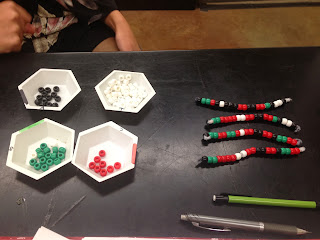2. James D Watson and Francis Crick had proposed a structure for the DNA molecule in 1953, that helped us understand hereditary and variation physically. It helped us sequence various organisms and their offspring, and look for any spontaneous changes in the long chain of DNA letters passed down from generation to generation.
3. Point mutation, insertion, gene copy number, duplication and regulatory changes are all examples of variations that occur to DNA.
Point mutation: Or single base substation, is a type of mutation that causes the replacement of a single base nucleotide with another nucleotide of the genetic material, DNA or RNA. This also includes insertions or deletions of a single based pair. For example in whipped dogs, a single based pair change makes the difference between a slender silhouette and a hulking animal. The mutation inactivates the gene for a signaling molecule that regulates muscle growth is uncontrolled because there is no "stop" signal.
Insertion: Is the addition of one or more nucleotide base pairs into a DNA sequence. For example, in pea plants, an 800 base pair sequence inserted into a gene produces wrinkled peas instead of smoothed ones. The intruding DNA element disables a gene necessary for starch synthesis, altering the peas sugar and water content.
Gene Copy Number: Entire genes can be duplicated by copying errors during cell division, leading to differences between species and variation among the individuals of the same species. For example, the genome of chimpanzees, which have a diet consisting of mostly green plants, normally contains just a single gene for the starch-digesting enzyme salivary amylase, where as humans can carry up to 10 copies of that gene.
Duplication: Sequences containing the same based pair copied and repeated eight or more times, known as homopolymers, are highly prone to copying errors. For example, in pigs, the gain of two additional C-G pairs in such as sequence inactivates a gene for a signal receptor in pigment cells, producing light colored coats. Copying mistakes in the individual cells can also cause the lose of bases which restores the gene's function and causes dark colored spots in the coats.
Regulatory Changes: Mutations in the DNA that controls when and where genes are activated can produce profound trait changes by altering the formation of body parts during the development of the organism. For example, the shape difference between the bushy teosinte plant and its descendant the modern cornstalk are different because of the change in the regulatory regions of a single gene that controls patterns of cell division during stem development.
4. Evo-devo is a subspecialty within evolutionary biology that concentrates on studying the effects of changes in important developmental genes and the role they play in evolution. It adresses the origin and evolution of embryonic development; how modifications of development and developmental processes lead to the production of novel features, such as feathers; the role of developmental plasticity in evolution; how ecology impacts development and evolutionary change; and the developmental basis of homology.
5. In the case of some dietary adaptations, the changes enabled entire populations to migrate and take up new ways of life, such as herding and agriculture. An example of such as trait, the ability to digest milk into adulthood, is found to have risen independently in groups on different continents, attesting to the great nutritional advantage the variant provides and to the possibility of directly connecting simple DNA sequence changes to human cultural evolution. Lactose intolerant people cannot digest complex milk sugar lactose because of the lack of lactase produced. Its retention in milk dependent societies also illustrates how culture can reinforce the forces of evolution.































